NURS 2006 Assignment 3: Evidence-Based Search Strategy and Analysis
VerifiedAdded on 2022/10/04
|14
|2637
|245
Report
AI Summary
This nursing assignment delves into the critical importance of hand hygiene in preventing hospital-acquired infections. The assignment begins with an introduction highlighting the significance of this issue, referencing statistics on nosocomial infections and the Australian government's concerns. It then provides background information, defining hospital-acquired infections and their causes, particularly focusing on the impact of hand hygiene compliance. The core of the assignment is the development of a search strategy, detailing the selection of the PubMed database, keywords, inclusion and exclusion criteria, and Boolean operators used to identify relevant research articles. The assignment also includes a discussion of the search strategy's impact on the student's understanding of evidence-based practice, highlighting the challenges encountered and the benefits of the process. The student reflects on the value of the PICO framework and the development of a comprehensive search strategy for clinical research. Finally, the assignment includes references to support the claims and an appendix with a summary table of the included articles.

Running head: NURSING ASSIGMENT
NURSING ASSIGMENT
Name of the student
Name of the university
Author note
NURSING ASSIGMENT
Name of the student
Name of the university
Author note
Paraphrase This Document
Need a fresh take? Get an instant paraphrase of this document with our AI Paraphraser
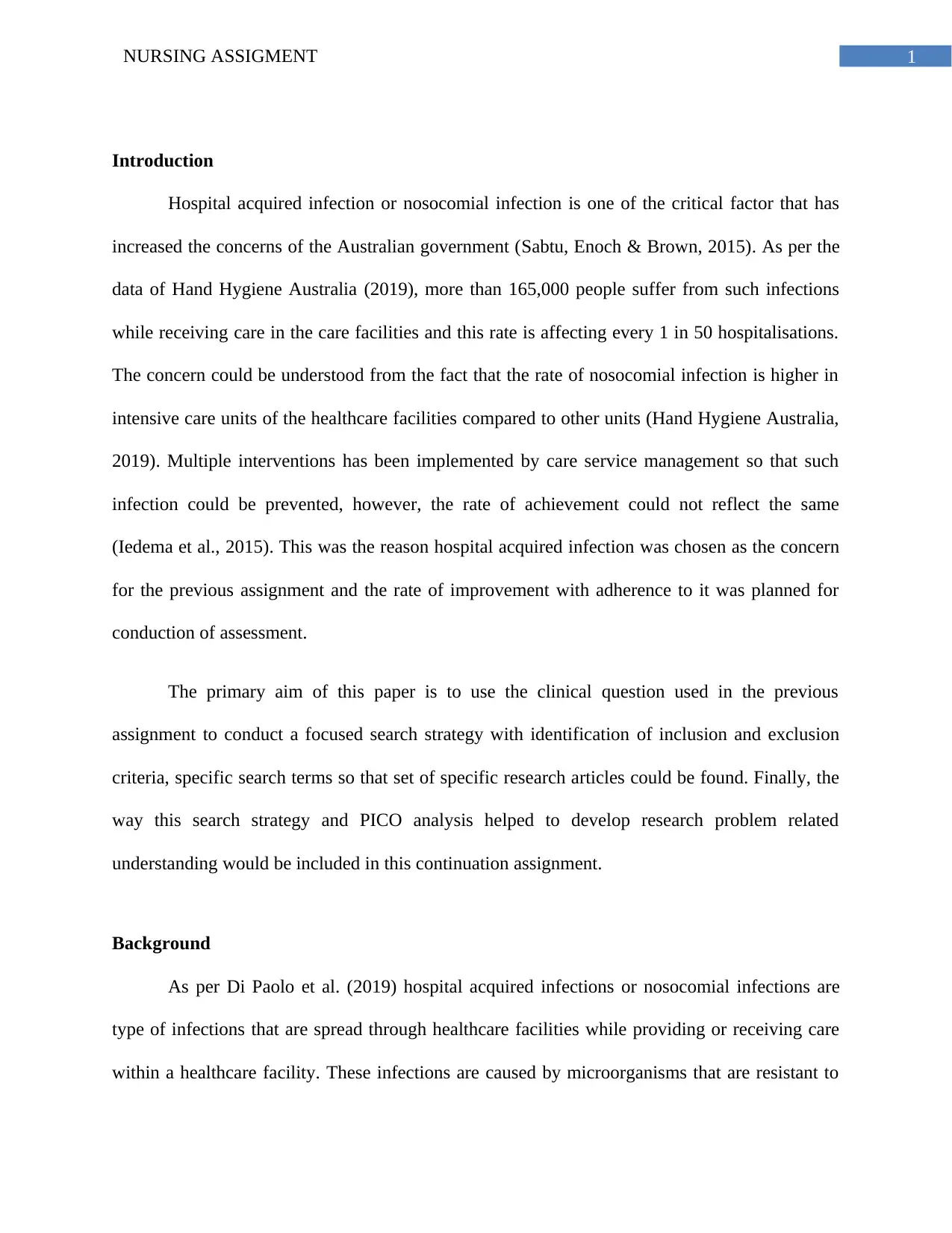
NURSING ASSIGMENT 1
Introduction
Hospital acquired infection or nosocomial infection is one of the critical factor that has
increased the concerns of the Australian government (Sabtu, Enoch & Brown, 2015). As per the
data of Hand Hygiene Australia (2019), more than 165,000 people suffer from such infections
while receiving care in the care facilities and this rate is affecting every 1 in 50 hospitalisations.
The concern could be understood from the fact that the rate of nosocomial infection is higher in
intensive care units of the healthcare facilities compared to other units (Hand Hygiene Australia,
2019). Multiple interventions has been implemented by care service management so that such
infection could be prevented, however, the rate of achievement could not reflect the same
(Iedema et al., 2015). This was the reason hospital acquired infection was chosen as the concern
for the previous assignment and the rate of improvement with adherence to it was planned for
conduction of assessment.
The primary aim of this paper is to use the clinical question used in the previous
assignment to conduct a focused search strategy with identification of inclusion and exclusion
criteria, specific search terms so that set of specific research articles could be found. Finally, the
way this search strategy and PICO analysis helped to develop research problem related
understanding would be included in this continuation assignment.
Background
As per Di Paolo et al. (2019) hospital acquired infections or nosocomial infections are
type of infections that are spread through healthcare facilities while providing or receiving care
within a healthcare facility. These infections are caused by microorganisms that are resistant to
Introduction
Hospital acquired infection or nosocomial infection is one of the critical factor that has
increased the concerns of the Australian government (Sabtu, Enoch & Brown, 2015). As per the
data of Hand Hygiene Australia (2019), more than 165,000 people suffer from such infections
while receiving care in the care facilities and this rate is affecting every 1 in 50 hospitalisations.
The concern could be understood from the fact that the rate of nosocomial infection is higher in
intensive care units of the healthcare facilities compared to other units (Hand Hygiene Australia,
2019). Multiple interventions has been implemented by care service management so that such
infection could be prevented, however, the rate of achievement could not reflect the same
(Iedema et al., 2015). This was the reason hospital acquired infection was chosen as the concern
for the previous assignment and the rate of improvement with adherence to it was planned for
conduction of assessment.
The primary aim of this paper is to use the clinical question used in the previous
assignment to conduct a focused search strategy with identification of inclusion and exclusion
criteria, specific search terms so that set of specific research articles could be found. Finally, the
way this search strategy and PICO analysis helped to develop research problem related
understanding would be included in this continuation assignment.
Background
As per Di Paolo et al. (2019) hospital acquired infections or nosocomial infections are
type of infections that are spread through healthcare facilities while providing or receiving care
within a healthcare facility. These infections are caused by microorganisms that are resistant to

NURSING ASSIGMENT 2
antibiotics or are spread through activities such as talking, sneezing, coughing and others. As per
Iedema et al. (2015), one of the primary reason that has been found to be responsible for the
highest number of nosocomial infection in patients are improper hygiene status, non- compliance
to the hand hygiene protocol of healthcare process and irregular unhygienic practices that are
practiced by the visitors within care facility (Australian Nursing and Midwifery Journal, 2018).
This indicated towards the gaps and limitations of healthcare facilities or managements to
implement these above- mentioned practices in their care facility so that the risk of such
infections could be minimized (Chowdhary, Sharma & Meis, 2017). Further, it also identified
that if the care facility implements these aspects diligently, then the rate of infection could be
controlled, however, the achievability of this gaol was questionable. Hence, the clinical question
was framed in such a way so that the comparison between compliance of hand hygiene could be
compared to non- compliance of it to analyse the effectiveness of this intervention, in controlling
nosocomial infections (Hand Hygiene Australia, 2019).
This clinical question is important for the development of clinical practice standards and
increasing the knowledge of healthcare professionals working in the healthcare facilities. In a
recent report published in Australian Nursing and Midwifery Journal (2018) identified that
Australian healthcare facilities are suffering from dynamic drop in their health hygiene
compliance strategy. As per this report, if the care professionals are not observed, the rate of
hand hygiene compliance falls from 90% to 30% and this research statistical data completely
denies the governmental data of complete hand hygiene compliance (Australian Nursing and
Midwifery Journal, 2018). Hence, this study clearly identifies that there is a huge gap between
the governmental guidelines and the implementation in care facilities. Due to this, patients as
well as healthcare professionals are suffering from critical infectious diseases that not only
antibiotics or are spread through activities such as talking, sneezing, coughing and others. As per
Iedema et al. (2015), one of the primary reason that has been found to be responsible for the
highest number of nosocomial infection in patients are improper hygiene status, non- compliance
to the hand hygiene protocol of healthcare process and irregular unhygienic practices that are
practiced by the visitors within care facility (Australian Nursing and Midwifery Journal, 2018).
This indicated towards the gaps and limitations of healthcare facilities or managements to
implement these above- mentioned practices in their care facility so that the risk of such
infections could be minimized (Chowdhary, Sharma & Meis, 2017). Further, it also identified
that if the care facility implements these aspects diligently, then the rate of infection could be
controlled, however, the achievability of this gaol was questionable. Hence, the clinical question
was framed in such a way so that the comparison between compliance of hand hygiene could be
compared to non- compliance of it to analyse the effectiveness of this intervention, in controlling
nosocomial infections (Hand Hygiene Australia, 2019).
This clinical question is important for the development of clinical practice standards and
increasing the knowledge of healthcare professionals working in the healthcare facilities. In a
recent report published in Australian Nursing and Midwifery Journal (2018) identified that
Australian healthcare facilities are suffering from dynamic drop in their health hygiene
compliance strategy. As per this report, if the care professionals are not observed, the rate of
hand hygiene compliance falls from 90% to 30% and this research statistical data completely
denies the governmental data of complete hand hygiene compliance (Australian Nursing and
Midwifery Journal, 2018). Hence, this study clearly identifies that there is a huge gap between
the governmental guidelines and the implementation in care facilities. Due to this, patients as
well as healthcare professionals are suffering from critical infectious diseases that not only
⊘ This is a preview!⊘
Do you want full access?
Subscribe today to unlock all pages.

Trusted by 1+ million students worldwide

NURSING ASSIGMENT 3
affecting their health and wellbeing, but also affecting the economy of the country (Australian
Nursing and Midwifery Journal, 2018). Further, the governmental audit report mentioned that the
rate of hand hygiene compliance was found lower in critical care units such as emergency
department (72%), critical care unit (80%) and maternity ward (81%). The lowest compliance
rate was associated with domestic care professionals (72%), medical practitioners (73%), and
student doctor and nurses (79%). Hence, conduction of this research process would be effective
for the clinical process and practice in future.
Search strategy
While developing a search strategy for any clinical question, it is importance to sieve
recent research articles so that evidence based practice could be conducted. In this aspect the
databases in which these research articles would be searched using specific research key terms
becomes critical (Hadi & Closs, 2016). There are multiple databases with thousands of research
articles with primary or secondary research processes however; Pub Med is the database that
would be selected for the conduction of search for this clinical question. As per Coordinators
(2017), Pub Med is a database with thousands of research articles that are tagged with keywords
that indicates their importance in the evidence based practices such as the type of study
conducted by the researcher and their major processes. Further, Pub Med is known to have the
most vast and accurate collection of clinical as well as biomedical research articles. Hence, these
are the aspects that make this scientific database accurate for this search strategy that would help
to answer the research question.
The second step would be determining keywords that would be used for the identification
of keywords so that while search for those research articles, these keywords could be used to
affecting their health and wellbeing, but also affecting the economy of the country (Australian
Nursing and Midwifery Journal, 2018). Further, the governmental audit report mentioned that the
rate of hand hygiene compliance was found lower in critical care units such as emergency
department (72%), critical care unit (80%) and maternity ward (81%). The lowest compliance
rate was associated with domestic care professionals (72%), medical practitioners (73%), and
student doctor and nurses (79%). Hence, conduction of this research process would be effective
for the clinical process and practice in future.
Search strategy
While developing a search strategy for any clinical question, it is importance to sieve
recent research articles so that evidence based practice could be conducted. In this aspect the
databases in which these research articles would be searched using specific research key terms
becomes critical (Hadi & Closs, 2016). There are multiple databases with thousands of research
articles with primary or secondary research processes however; Pub Med is the database that
would be selected for the conduction of search for this clinical question. As per Coordinators
(2017), Pub Med is a database with thousands of research articles that are tagged with keywords
that indicates their importance in the evidence based practices such as the type of study
conducted by the researcher and their major processes. Further, Pub Med is known to have the
most vast and accurate collection of clinical as well as biomedical research articles. Hence, these
are the aspects that make this scientific database accurate for this search strategy that would help
to answer the research question.
The second step would be determining keywords that would be used for the identification
of keywords so that while search for those research articles, these keywords could be used to
Paraphrase This Document
Need a fresh take? Get an instant paraphrase of this document with our AI Paraphraser
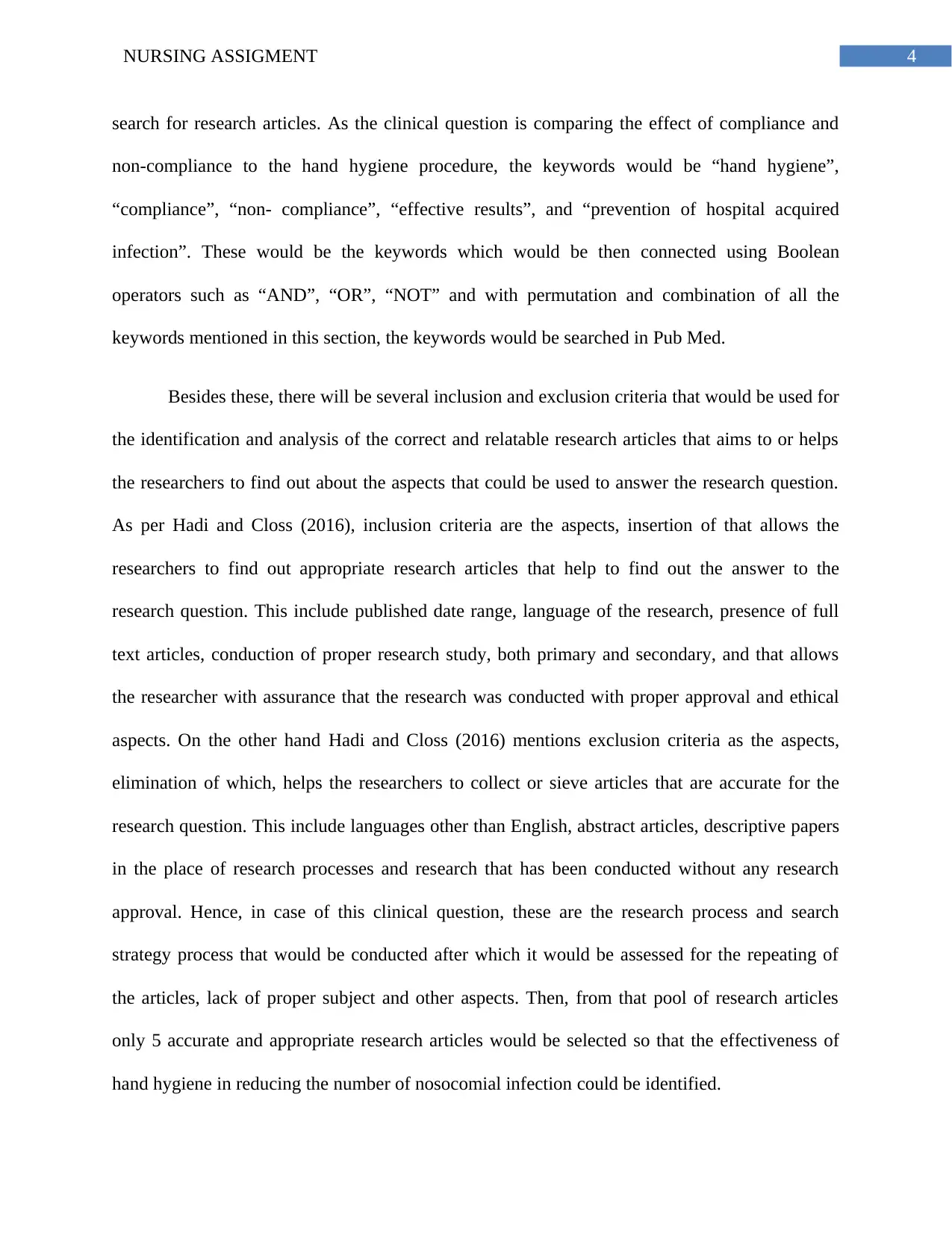
NURSING ASSIGMENT 4
search for research articles. As the clinical question is comparing the effect of compliance and
non-compliance to the hand hygiene procedure, the keywords would be “hand hygiene”,
“compliance”, “non- compliance”, “effective results”, and “prevention of hospital acquired
infection”. These would be the keywords which would be then connected using Boolean
operators such as “AND”, “OR”, “NOT” and with permutation and combination of all the
keywords mentioned in this section, the keywords would be searched in Pub Med.
Besides these, there will be several inclusion and exclusion criteria that would be used for
the identification and analysis of the correct and relatable research articles that aims to or helps
the researchers to find out about the aspects that could be used to answer the research question.
As per Hadi and Closs (2016), inclusion criteria are the aspects, insertion of that allows the
researchers to find out appropriate research articles that help to find out the answer to the
research question. This include published date range, language of the research, presence of full
text articles, conduction of proper research study, both primary and secondary, and that allows
the researcher with assurance that the research was conducted with proper approval and ethical
aspects. On the other hand Hadi and Closs (2016) mentions exclusion criteria as the aspects,
elimination of which, helps the researchers to collect or sieve articles that are accurate for the
research question. This include languages other than English, abstract articles, descriptive papers
in the place of research processes and research that has been conducted without any research
approval. Hence, in case of this clinical question, these are the research process and search
strategy process that would be conducted after which it would be assessed for the repeating of
the articles, lack of proper subject and other aspects. Then, from that pool of research articles
only 5 accurate and appropriate research articles would be selected so that the effectiveness of
hand hygiene in reducing the number of nosocomial infection could be identified.
search for research articles. As the clinical question is comparing the effect of compliance and
non-compliance to the hand hygiene procedure, the keywords would be “hand hygiene”,
“compliance”, “non- compliance”, “effective results”, and “prevention of hospital acquired
infection”. These would be the keywords which would be then connected using Boolean
operators such as “AND”, “OR”, “NOT” and with permutation and combination of all the
keywords mentioned in this section, the keywords would be searched in Pub Med.
Besides these, there will be several inclusion and exclusion criteria that would be used for
the identification and analysis of the correct and relatable research articles that aims to or helps
the researchers to find out about the aspects that could be used to answer the research question.
As per Hadi and Closs (2016), inclusion criteria are the aspects, insertion of that allows the
researchers to find out appropriate research articles that help to find out the answer to the
research question. This include published date range, language of the research, presence of full
text articles, conduction of proper research study, both primary and secondary, and that allows
the researcher with assurance that the research was conducted with proper approval and ethical
aspects. On the other hand Hadi and Closs (2016) mentions exclusion criteria as the aspects,
elimination of which, helps the researchers to collect or sieve articles that are accurate for the
research question. This include languages other than English, abstract articles, descriptive papers
in the place of research processes and research that has been conducted without any research
approval. Hence, in case of this clinical question, these are the research process and search
strategy process that would be conducted after which it would be assessed for the repeating of
the articles, lack of proper subject and other aspects. Then, from that pool of research articles
only 5 accurate and appropriate research articles would be selected so that the effectiveness of
hand hygiene in reducing the number of nosocomial infection could be identified.
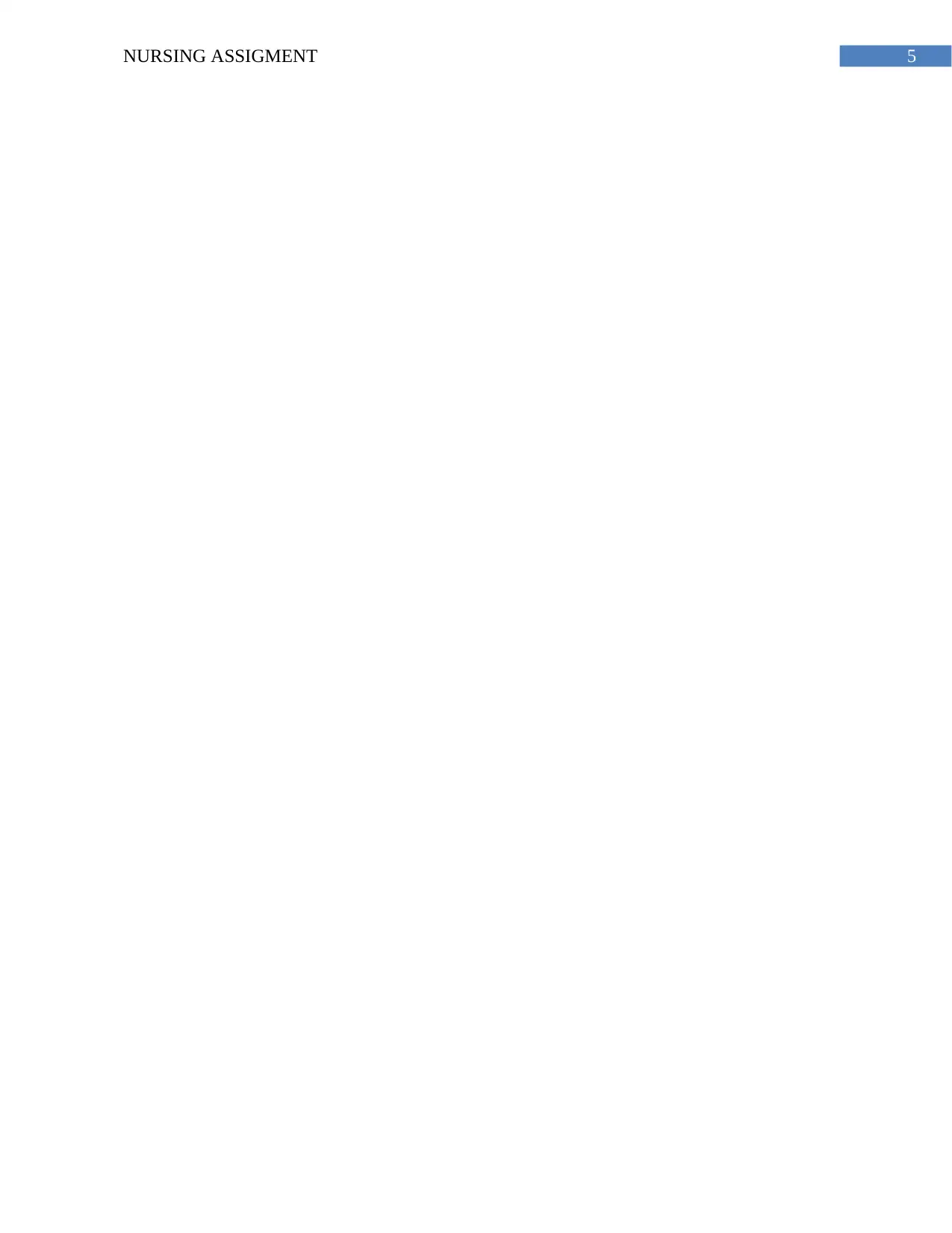
NURSING ASSIGMENT 5
⊘ This is a preview!⊘
Do you want full access?
Subscribe today to unlock all pages.

Trusted by 1+ million students worldwide
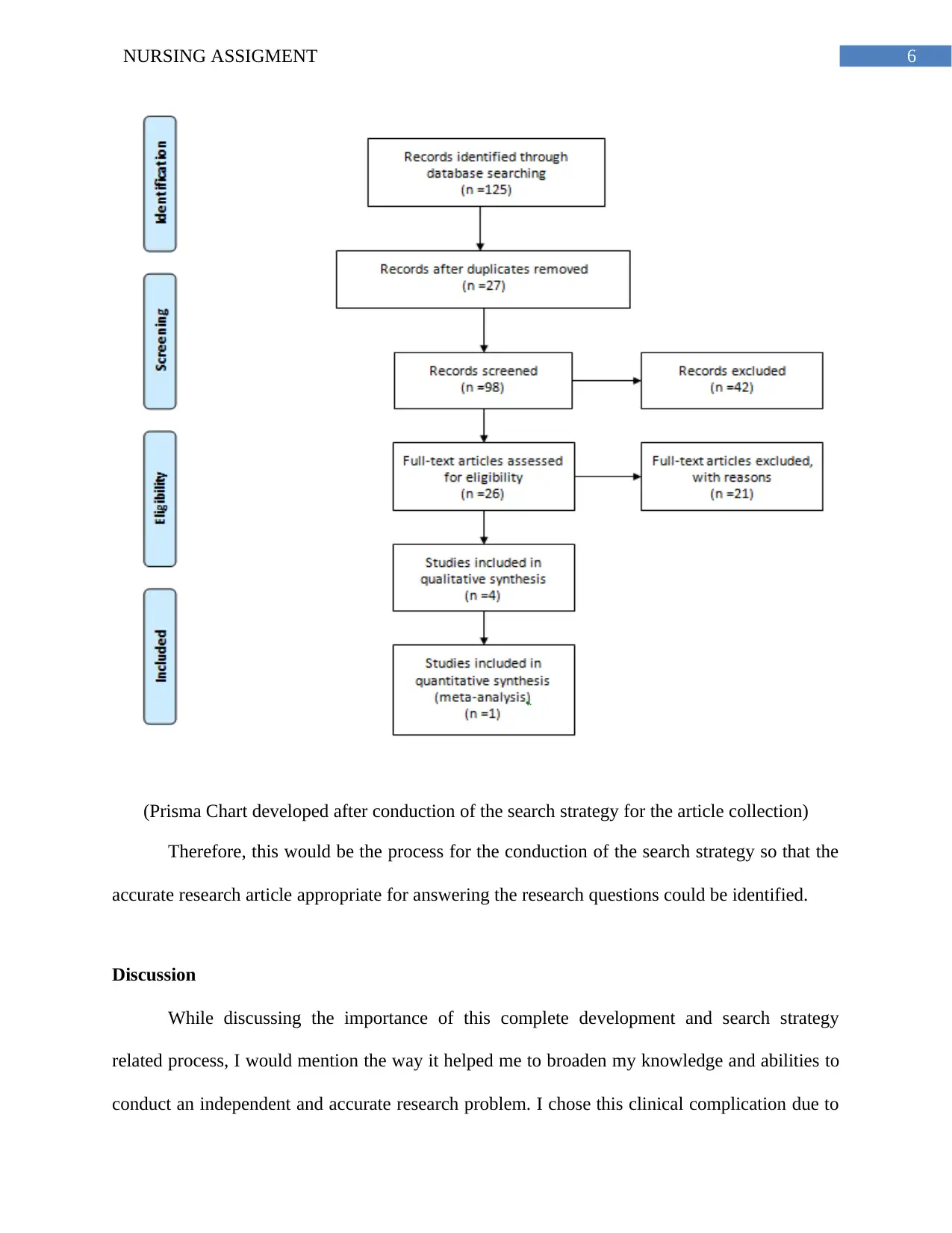
NURSING ASSIGMENT 6
(Prisma Chart developed after conduction of the search strategy for the article collection)
Therefore, this would be the process for the conduction of the search strategy so that the
accurate research article appropriate for answering the research questions could be identified.
Discussion
While discussing the importance of this complete development and search strategy
related process, I would mention the way it helped me to broaden my knowledge and abilities to
conduct an independent and accurate research problem. I chose this clinical complication due to
(Prisma Chart developed after conduction of the search strategy for the article collection)
Therefore, this would be the process for the conduction of the search strategy so that the
accurate research article appropriate for answering the research questions could be identified.
Discussion
While discussing the importance of this complete development and search strategy
related process, I would mention the way it helped me to broaden my knowledge and abilities to
conduct an independent and accurate research problem. I chose this clinical complication due to
Paraphrase This Document
Need a fresh take? Get an instant paraphrase of this document with our AI Paraphraser
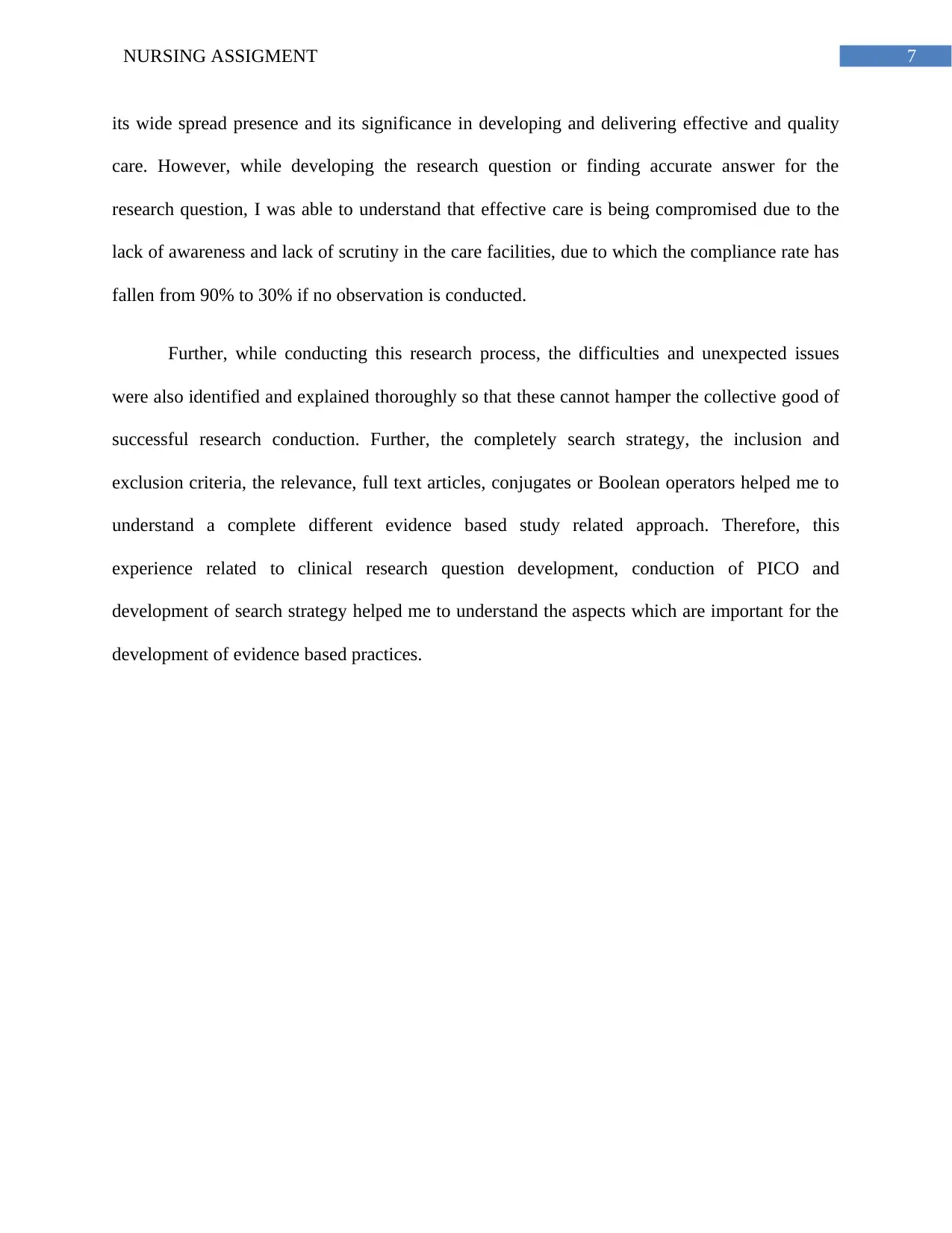
NURSING ASSIGMENT 7
its wide spread presence and its significance in developing and delivering effective and quality
care. However, while developing the research question or finding accurate answer for the
research question, I was able to understand that effective care is being compromised due to the
lack of awareness and lack of scrutiny in the care facilities, due to which the compliance rate has
fallen from 90% to 30% if no observation is conducted.
Further, while conducting this research process, the difficulties and unexpected issues
were also identified and explained thoroughly so that these cannot hamper the collective good of
successful research conduction. Further, the completely search strategy, the inclusion and
exclusion criteria, the relevance, full text articles, conjugates or Boolean operators helped me to
understand a complete different evidence based study related approach. Therefore, this
experience related to clinical research question development, conduction of PICO and
development of search strategy helped me to understand the aspects which are important for the
development of evidence based practices.
its wide spread presence and its significance in developing and delivering effective and quality
care. However, while developing the research question or finding accurate answer for the
research question, I was able to understand that effective care is being compromised due to the
lack of awareness and lack of scrutiny in the care facilities, due to which the compliance rate has
fallen from 90% to 30% if no observation is conducted.
Further, while conducting this research process, the difficulties and unexpected issues
were also identified and explained thoroughly so that these cannot hamper the collective good of
successful research conduction. Further, the completely search strategy, the inclusion and
exclusion criteria, the relevance, full text articles, conjugates or Boolean operators helped me to
understand a complete different evidence based study related approach. Therefore, this
experience related to clinical research question development, conduction of PICO and
development of search strategy helped me to understand the aspects which are important for the
development of evidence based practices.
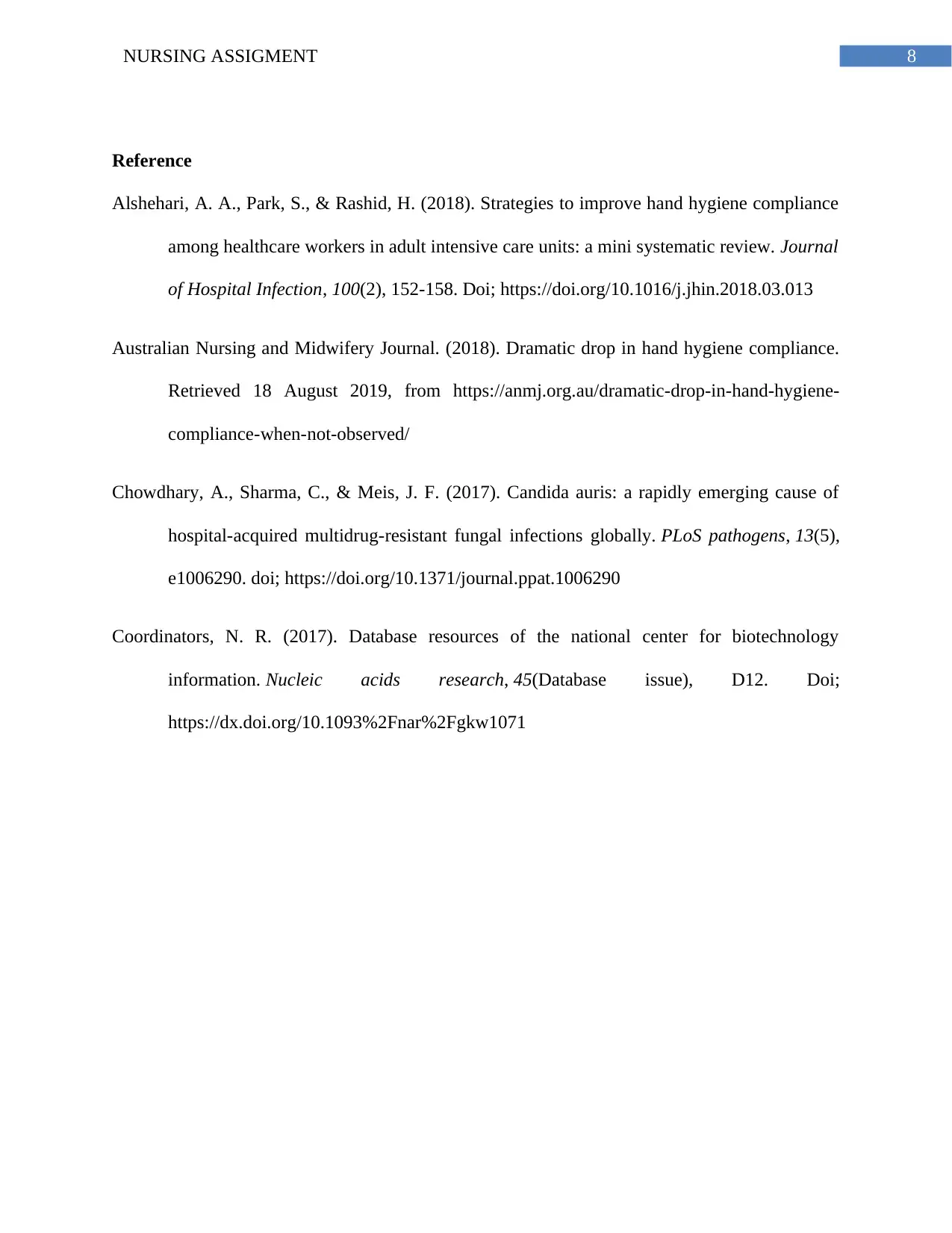
NURSING ASSIGMENT 8
Reference
Alshehari, A. A., Park, S., & Rashid, H. (2018). Strategies to improve hand hygiene compliance
among healthcare workers in adult intensive care units: a mini systematic review. Journal
of Hospital Infection, 100(2), 152-158. Doi; https://doi.org/10.1016/j.jhin.2018.03.013
Australian Nursing and Midwifery Journal. (2018). Dramatic drop in hand hygiene compliance.
Retrieved 18 August 2019, from https://anmj.org.au/dramatic-drop-in-hand-hygiene-
compliance-when-not-observed/
Chowdhary, A., Sharma, C., & Meis, J. F. (2017). Candida auris: a rapidly emerging cause of
hospital-acquired multidrug-resistant fungal infections globally. PLoS pathogens, 13(5),
e1006290. doi; https://doi.org/10.1371/journal.ppat.1006290
Coordinators, N. R. (2017). Database resources of the national center for biotechnology
information. Nucleic acids research, 45(Database issue), D12. Doi;
https://dx.doi.org/10.1093%2Fnar%2Fgkw1071
Reference
Alshehari, A. A., Park, S., & Rashid, H. (2018). Strategies to improve hand hygiene compliance
among healthcare workers in adult intensive care units: a mini systematic review. Journal
of Hospital Infection, 100(2), 152-158. Doi; https://doi.org/10.1016/j.jhin.2018.03.013
Australian Nursing and Midwifery Journal. (2018). Dramatic drop in hand hygiene compliance.
Retrieved 18 August 2019, from https://anmj.org.au/dramatic-drop-in-hand-hygiene-
compliance-when-not-observed/
Chowdhary, A., Sharma, C., & Meis, J. F. (2017). Candida auris: a rapidly emerging cause of
hospital-acquired multidrug-resistant fungal infections globally. PLoS pathogens, 13(5),
e1006290. doi; https://doi.org/10.1371/journal.ppat.1006290
Coordinators, N. R. (2017). Database resources of the national center for biotechnology
information. Nucleic acids research, 45(Database issue), D12. Doi;
https://dx.doi.org/10.1093%2Fnar%2Fgkw1071
⊘ This is a preview!⊘
Do you want full access?
Subscribe today to unlock all pages.

Trusted by 1+ million students worldwide
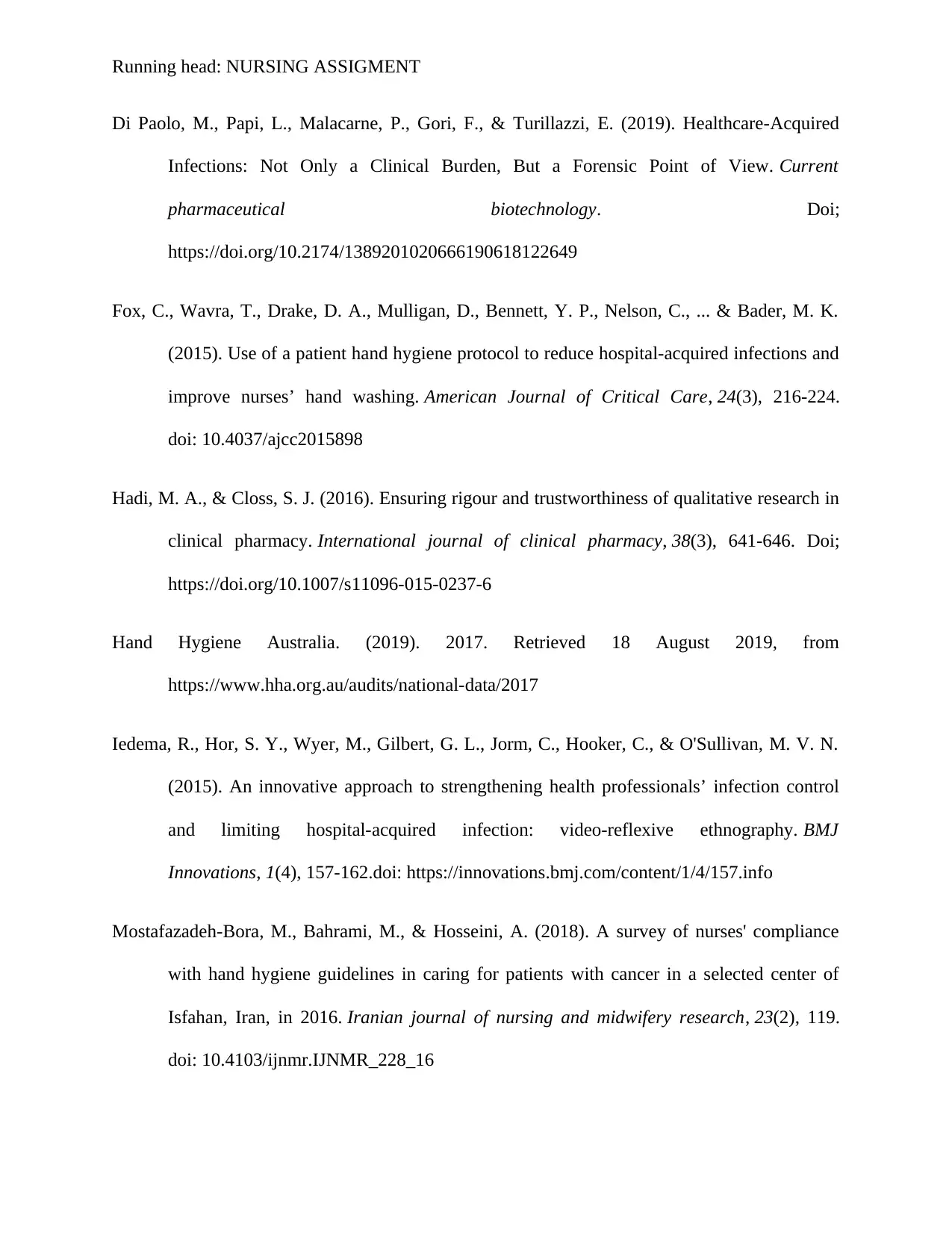
Running head: NURSING ASSIGMENT
Di Paolo, M., Papi, L., Malacarne, P., Gori, F., & Turillazzi, E. (2019). Healthcare-Acquired
Infections: Not Only a Clinical Burden, But a Forensic Point of View. Current
pharmaceutical biotechnology. Doi;
https://doi.org/10.2174/1389201020666190618122649
Fox, C., Wavra, T., Drake, D. A., Mulligan, D., Bennett, Y. P., Nelson, C., ... & Bader, M. K.
(2015). Use of a patient hand hygiene protocol to reduce hospital-acquired infections and
improve nurses’ hand washing. American Journal of Critical Care, 24(3), 216-224.
doi: 10.4037/ajcc2015898
Hadi, M. A., & Closs, S. J. (2016). Ensuring rigour and trustworthiness of qualitative research in
clinical pharmacy. International journal of clinical pharmacy, 38(3), 641-646. Doi;
https://doi.org/10.1007/s11096-015-0237-6
Hand Hygiene Australia. (2019). 2017. Retrieved 18 August 2019, from
https://www.hha.org.au/audits/national-data/2017
Iedema, R., Hor, S. Y., Wyer, M., Gilbert, G. L., Jorm, C., Hooker, C., & O'Sullivan, M. V. N.
(2015). An innovative approach to strengthening health professionals’ infection control
and limiting hospital-acquired infection: video-reflexive ethnography. BMJ
Innovations, 1(4), 157-162.doi: https://innovations.bmj.com/content/1/4/157.info
Mostafazadeh-Bora, M., Bahrami, M., & Hosseini, A. (2018). A survey of nurses' compliance
with hand hygiene guidelines in caring for patients with cancer in a selected center of
Isfahan, Iran, in 2016. Iranian journal of nursing and midwifery research, 23(2), 119.
doi: 10.4103/ijnmr.IJNMR_228_16
Di Paolo, M., Papi, L., Malacarne, P., Gori, F., & Turillazzi, E. (2019). Healthcare-Acquired
Infections: Not Only a Clinical Burden, But a Forensic Point of View. Current
pharmaceutical biotechnology. Doi;
https://doi.org/10.2174/1389201020666190618122649
Fox, C., Wavra, T., Drake, D. A., Mulligan, D., Bennett, Y. P., Nelson, C., ... & Bader, M. K.
(2015). Use of a patient hand hygiene protocol to reduce hospital-acquired infections and
improve nurses’ hand washing. American Journal of Critical Care, 24(3), 216-224.
doi: 10.4037/ajcc2015898
Hadi, M. A., & Closs, S. J. (2016). Ensuring rigour and trustworthiness of qualitative research in
clinical pharmacy. International journal of clinical pharmacy, 38(3), 641-646. Doi;
https://doi.org/10.1007/s11096-015-0237-6
Hand Hygiene Australia. (2019). 2017. Retrieved 18 August 2019, from
https://www.hha.org.au/audits/national-data/2017
Iedema, R., Hor, S. Y., Wyer, M., Gilbert, G. L., Jorm, C., Hooker, C., & O'Sullivan, M. V. N.
(2015). An innovative approach to strengthening health professionals’ infection control
and limiting hospital-acquired infection: video-reflexive ethnography. BMJ
Innovations, 1(4), 157-162.doi: https://innovations.bmj.com/content/1/4/157.info
Mostafazadeh-Bora, M., Bahrami, M., & Hosseini, A. (2018). A survey of nurses' compliance
with hand hygiene guidelines in caring for patients with cancer in a selected center of
Isfahan, Iran, in 2016. Iranian journal of nursing and midwifery research, 23(2), 119.
doi: 10.4103/ijnmr.IJNMR_228_16
Paraphrase This Document
Need a fresh take? Get an instant paraphrase of this document with our AI Paraphraser

1NURSING ASSIGMENT
Musu, M., Lai, A., Mereu, N. M., Galletta, M., Campagna, M., Tidore, M., ... & Mura, P. (2017).
Assessing hand hygiene compliance among healthcare workers in six Intensive Care
Units. Journal of preventive medicine and hygiene, 58(3), E231. Retrieved from:
https://www.ncbi.nlm.nih.gov/pmc/articles/PMC5668933/
Sabtu, N., Enoch, D. A., & Brown, N. M. (2015). Antibiotic resistance: what, why, where, when
and how?. British medical bulletin, 116(1). Retrieved from:
https://www.researchgate.net/profile/Nick_Brown18/publication/283211266_Antibiotic_r
esistance_What_why_where_when_and_how/links/58e7aaa4aca2729d8cd08de4/
Antibiotic-resistance-What-why-where-when-and-how.pdf
Shrestha, P. D., Rai, S., & Gaihre, S. (2018). Prevalence of Hospital Acquired Infection and its
Preventive Practices among Health Workers in a Tertiary Care Hospital. Journal of
Nepal Health Research Council, 16(41), 452-456. Retrieved from:
https://www.ncbi.nlm.nih.gov/pubmed/30739939
Musu, M., Lai, A., Mereu, N. M., Galletta, M., Campagna, M., Tidore, M., ... & Mura, P. (2017).
Assessing hand hygiene compliance among healthcare workers in six Intensive Care
Units. Journal of preventive medicine and hygiene, 58(3), E231. Retrieved from:
https://www.ncbi.nlm.nih.gov/pmc/articles/PMC5668933/
Sabtu, N., Enoch, D. A., & Brown, N. M. (2015). Antibiotic resistance: what, why, where, when
and how?. British medical bulletin, 116(1). Retrieved from:
https://www.researchgate.net/profile/Nick_Brown18/publication/283211266_Antibiotic_r
esistance_What_why_where_when_and_how/links/58e7aaa4aca2729d8cd08de4/
Antibiotic-resistance-What-why-where-when-and-how.pdf
Shrestha, P. D., Rai, S., & Gaihre, S. (2018). Prevalence of Hospital Acquired Infection and its
Preventive Practices among Health Workers in a Tertiary Care Hospital. Journal of
Nepal Health Research Council, 16(41), 452-456. Retrieved from:
https://www.ncbi.nlm.nih.gov/pubmed/30739939
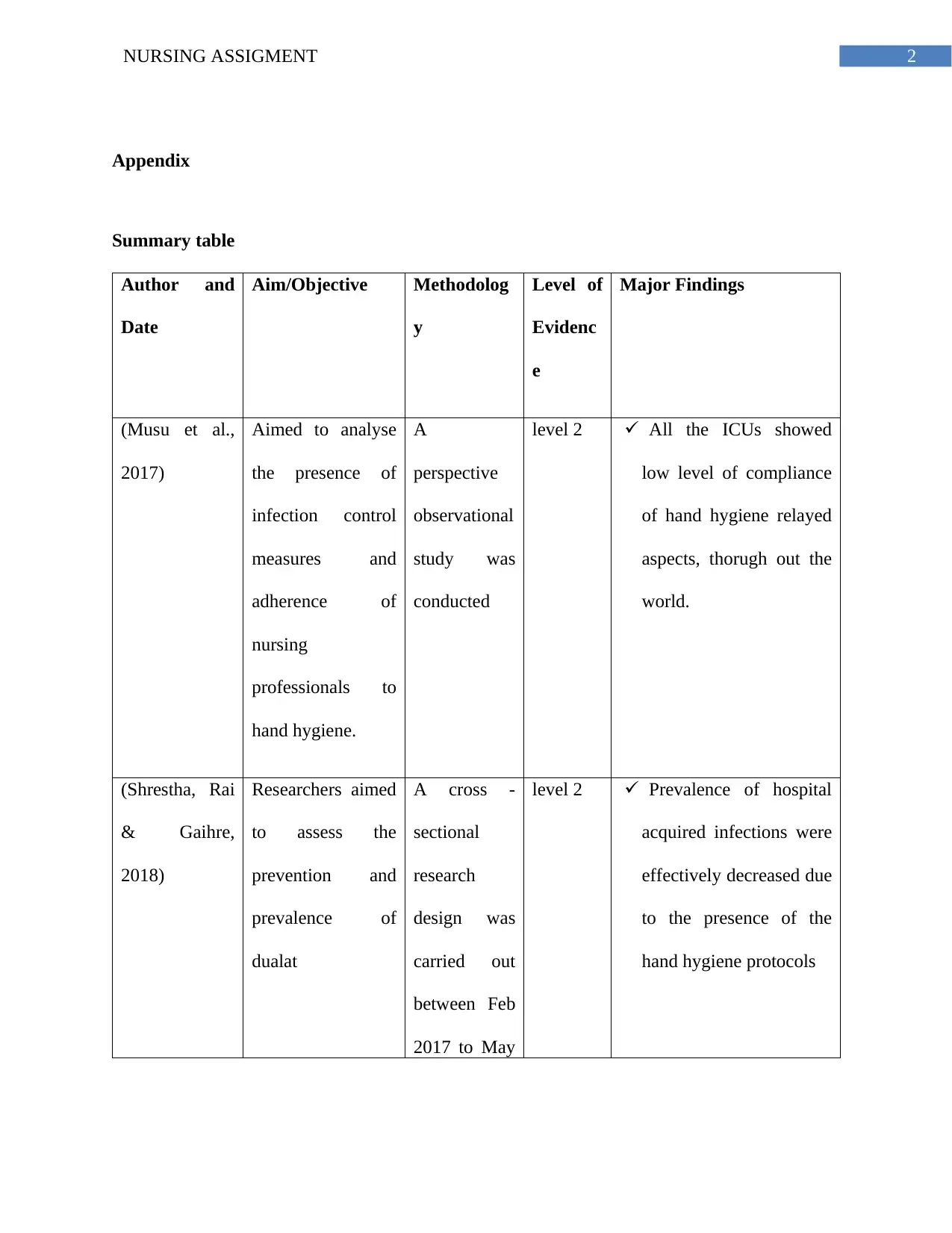
2NURSING ASSIGMENT
Appendix
Summary table
Author and
Date
Aim/Objective Methodolog
y
Level of
Evidenc
e
Major Findings
(Musu et al.,
2017)
Aimed to analyse
the presence of
infection control
measures and
adherence of
nursing
professionals to
hand hygiene.
A
perspective
observational
study was
conducted
level 2 All the ICUs showed
low level of compliance
of hand hygiene relayed
aspects, thorugh out the
world.
(Shrestha, Rai
& Gaihre,
2018)
Researchers aimed
to assess the
prevention and
prevalence of
dualat
A cross -
sectional
research
design was
carried out
between Feb
2017 to May
level 2 Prevalence of hospital
acquired infections were
effectively decreased due
to the presence of the
hand hygiene protocols
Appendix
Summary table
Author and
Date
Aim/Objective Methodolog
y
Level of
Evidenc
e
Major Findings
(Musu et al.,
2017)
Aimed to analyse
the presence of
infection control
measures and
adherence of
nursing
professionals to
hand hygiene.
A
perspective
observational
study was
conducted
level 2 All the ICUs showed
low level of compliance
of hand hygiene relayed
aspects, thorugh out the
world.
(Shrestha, Rai
& Gaihre,
2018)
Researchers aimed
to assess the
prevention and
prevalence of
dualat
A cross -
sectional
research
design was
carried out
between Feb
2017 to May
level 2 Prevalence of hospital
acquired infections were
effectively decreased due
to the presence of the
hand hygiene protocols
⊘ This is a preview!⊘
Do you want full access?
Subscribe today to unlock all pages.

Trusted by 1+ million students worldwide
1 out of 14
Related Documents
Your All-in-One AI-Powered Toolkit for Academic Success.
+13062052269
info@desklib.com
Available 24*7 on WhatsApp / Email
![[object Object]](/_next/static/media/star-bottom.7253800d.svg)
Unlock your academic potential
Copyright © 2020–2025 A2Z Services. All Rights Reserved. Developed and managed by ZUCOL.





